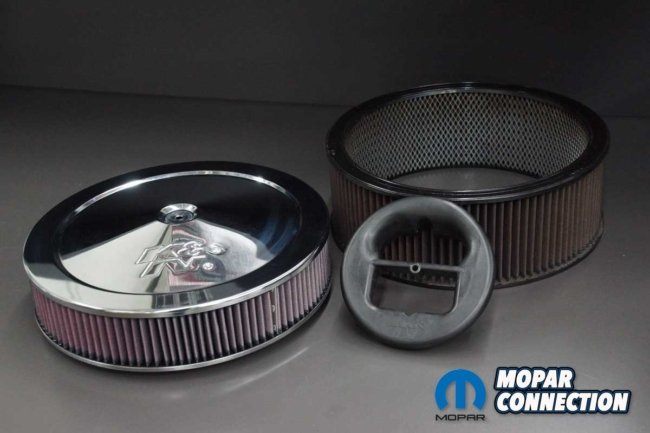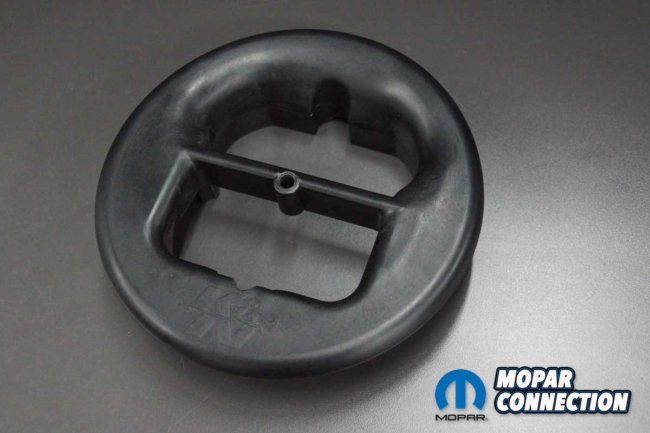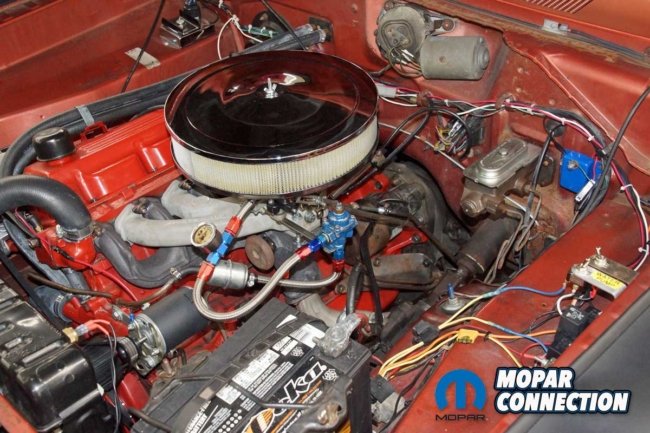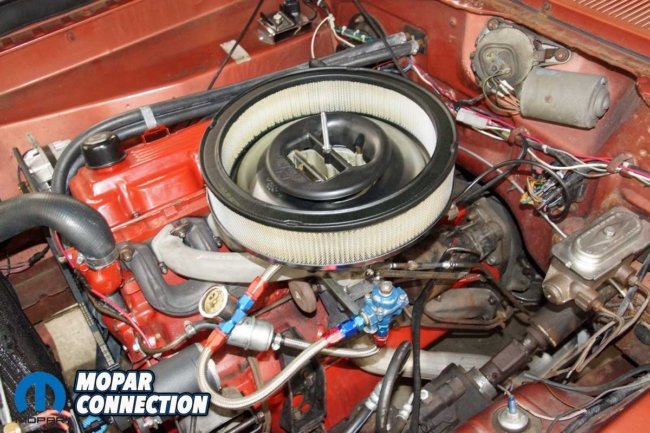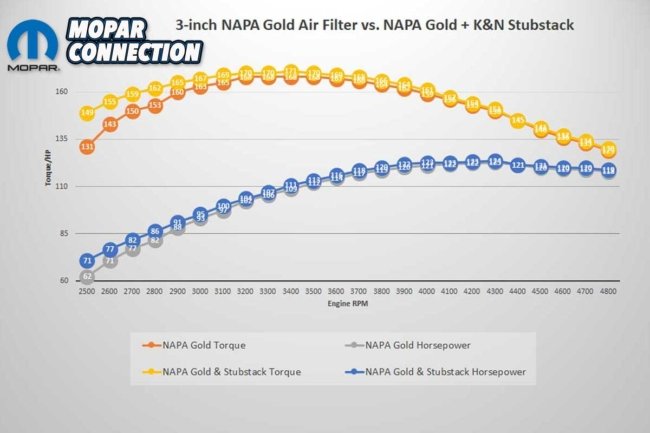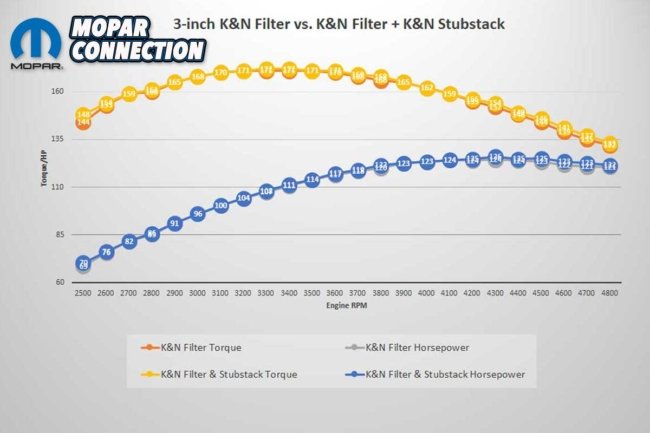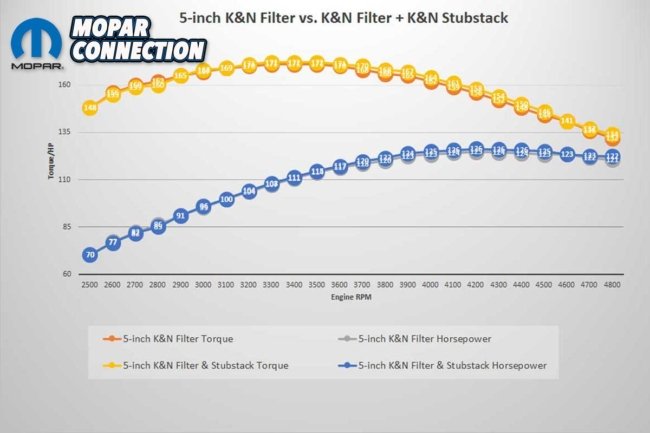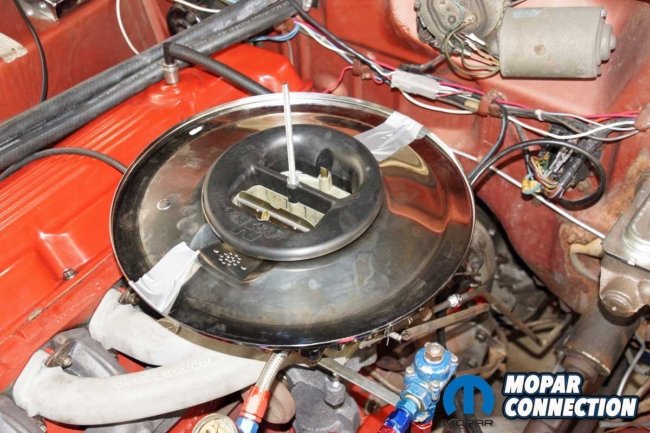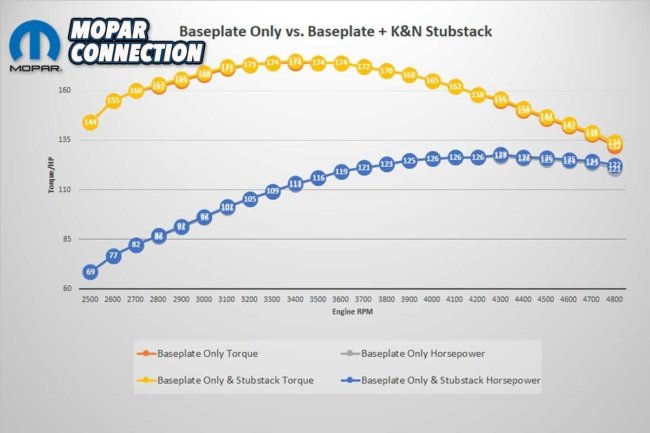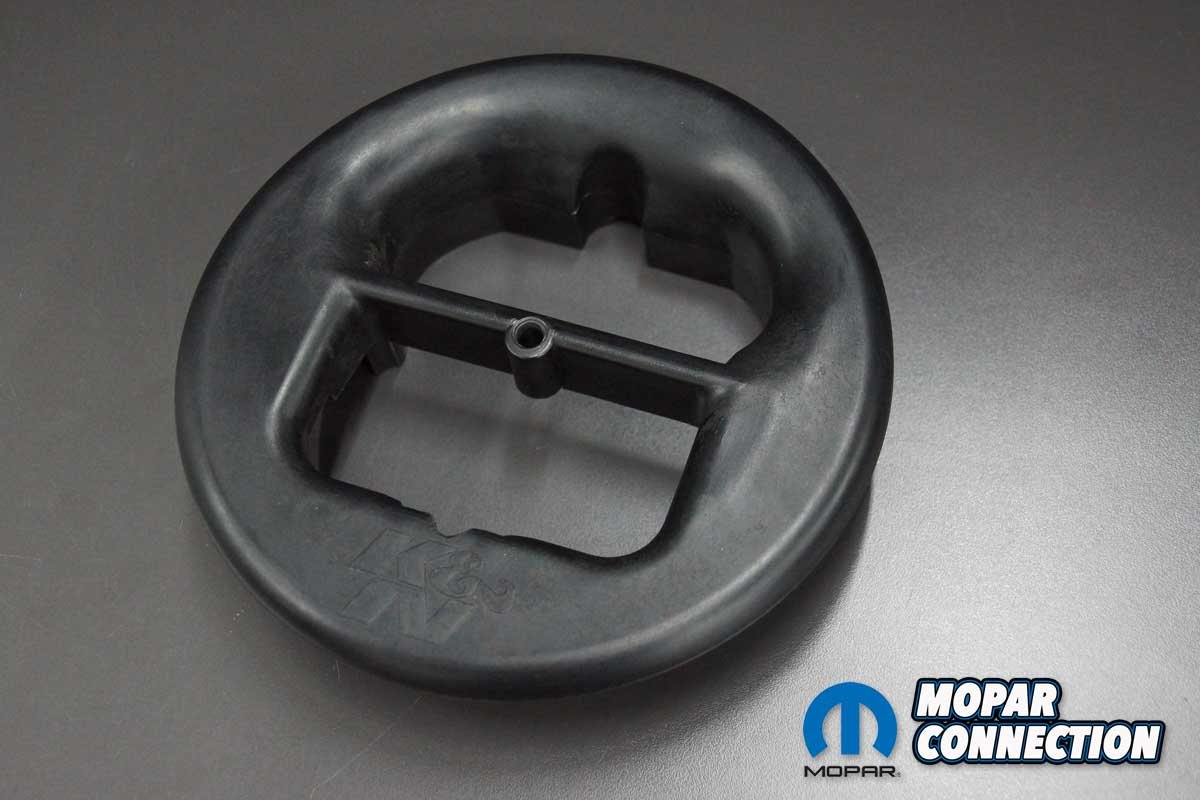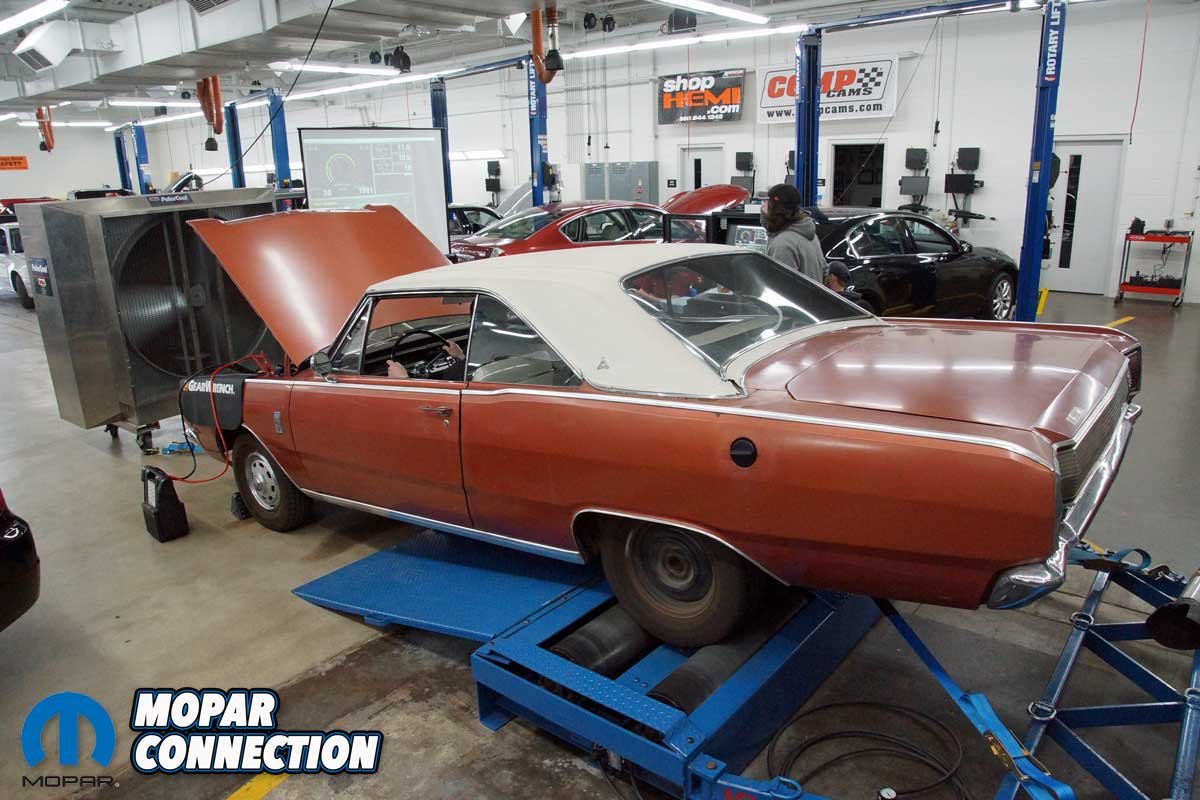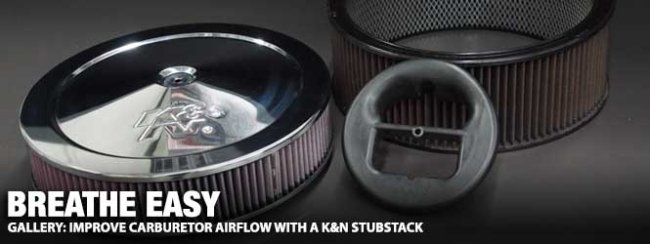
Nearly everyone has heard accounts about performance increases from the various K&N Stubstack designs. If you are not familiar with the Stubstack, it is designed to slip over the carburetor air inlet, and in theory, it reduces turbulence, improves metering accuracy, and increases the airflow by smoothing carburetor air horn restrictions.
The Stubstack intends to straighten and speed up the airflow through the carburetor. Mopar Connection Magazine decided to test a Holley 4150/4160 4bbl K&N Stubstack on a slant six-equipped 1967 Dart with a Holley 390 cubic feet per minute (CFM) carburetor mounted onto an Offenhauser intake manifold. A Mustang chassis dyno would be used to evaluate the K&N results.
The K&N Stubstack line covers the popular Holley 4150/4160, 4500, and 2300 carburetors with or without the choke air horn, and there is a design for the square bore Edelbrock carburetors. The Stubstack’s Polyurethane material can be easily drilled, filed, and sanded to meet the user’s needs. However, even with its ease of alteration, the Stubstack will not fit every carburetor due to varying carburetor castings and air horn designs. On the K&N website, there is a list of compatible carburetors.
Above Left: K&N has long been a leader in air filtration performance. To put the K&N products to the test, we selected a 3×14- and 5×14-inch air filter element and a Stubstack. A Mustang chassis dyno would be used to evaluate the products on our 1967 slant six-equipped Dart. Above Right: The Stubstack is designed to fit over the air horn of a Holley or Edelbrock carburetor. It is meant to reduce the airflow disruptions caused around the carburetor’s choke, which will increase and smooth the air entering the engine.
The Pennsylvania College of Technology “bolt-on” chassis dyno class provided the Dart for our extensive testing session. During the semester, the students prepared and updated the Dart. The slant six was a 0.030-inch over 225 with 0.060-inch shaved off the head. The engine used stock components, and the camshaft was a factory 1974 piece.
A Mopar Performance electronic ignition module and distributor handled the spark chores. An electric fan replaced the fixed fan, and an electric water pump drive substituted the crankshaft-driven water pump pulley. Lastly, the students installed an Accurate Exhaust Products 2 ¼-inch full exhaust and muffler on the Dart.
Above Left: The Pennsylvania College of Technology “Dyno Dart” has a rebuilt 225 slant six. The engine is stock internally, but it has been enhanced with “bolt-on” parts. Above Right: To establish a baseline series of runs, we ran the 225 with a NAPA Gold 3×14-inch air filter. The 225 laid down 168 lb-ft of peak torque and 123 peak horsepower (hp).
With the Dart strapped to the Mustang chassis dyno, the students warmed up the engine and the drivetrain before the baseline runs were performed from 2500-4800 rpm. A Napa Gold 3×14-inch air filter and housing were secured to the 390 carb. Three runs were performed, and the runs provided three nearly identical dyno graphs.
Each key data parameter (peak torque, average torque, peak horsepower, and average horsepower) was within 1% from trace to trace. The peak torque was 168 lb-ft with a peak of 123 horsepower (hp), and the average torque and horsepower were 154 lb-ft and 106 hp, respectively. Satisfied with the results, we moved forward with the Stubstack tests.
Above Left: After the series of baseline runs with the NAPA filter, we slipped the K&N Stubstack over the air horn of the carburetor and replaced the air filter lid. Above Right: With the addition of the Stubstack, the peak torque increased by three lb-ft, and the peak horsepower improved by one hp. The average torque was up four lb-ft, and the average horsepower increased by two hp. The low-end torque improvement was in the double-digits.
The air filter housing’s top plate was removed, and the Stubstack was guided over the carburetor stud and seated over the carb’s air horn. We secured the Stubstack with a nut on the stud and then replaced the top plate. After three runs, the peak torque increased by three lb-ft, and the horsepower increased by one hp. Although the numbers may seem insignificant, they were consistent rear wheel numbers.
The peak torque was up 1.79%, and the peak horsepower climbed by 0.81%. The average torque increased 2.35% to 158 lb-ft (+4), and the average hp rose 1.97% to 109 hp (+2). At 2500 rpm, the torque was 18 lb-ft greater with the Stubstack installed.
Above Left: The NAPA Gold filter and housing were swapped out for a 3×14-inch K&N Filtercharger, which included the filter and housing. K&N recommends the Filtercharger for maximum performance of the K&N Stubstack. Above Center: After three runs with just the filter and housing, the Stubstack was dropped over the carburetor. Above Right: The K&N air filter and housing maintained the gains that the Stubstack had with the NAPA filter. When the Stubstack was added to the K&N filter, the peak torque increased by one lb-ft to 172 lb-ft, and the peak horsepower rose by 2 hp to 126 hp.
K&N notes in its instructions that the Stubstack works best with a K&N Filtercharger, so we installed a 3×14-inch unit with a matching open-element K&N filter housing. The testing continued with the Filtercharger and without the Stubstack. The switch from the NAPA and Stubstack setup to the K&N Filtercharger did not change any of the results, but when we slipped the Stubstack under the air filter housing top plate, it added one extra lb-ft of torque and two additional hp.
The performance numbers with the 3-inch K&N filter and Stubstack were up to 172 lb-ft of peak torque (+0.58%) and 126 horsepower (+1.61%). The average torque increased by one lb-ft to 159 lb-ft, and the average horsepower increased by one hp to 110 hp.
Above Left: The K&N 5×14-inch filter was fitted between the K&N air filter tins. Although the 5-inch filter would not fit under the Dart’s hood, we had the filter available, so we tested it. Above Center: Just like the prior tests, after three successful runs, we added the Stubstack and performed three more runs. Above Right: The 5-inch filter provided insignificant performance changes. The 3- and 5-inch filters with the Stubstack provided the same 172 lb-ft of peak torque and 126 horsepower.
Although a 5×14-inch K&N filter would not fit under the hood, it was agreed it would be an interesting test. The peak torque, peak horsepower, and average torque numbers all dropped by a single digit. The average horsepower remained the same as the 3×14-inch K&N with the Stubstack. When we added the Stubstack, the peak torque, peak horsepower, and average hp returned to the same numbers as the 3×14-inch K&N filter with the Stubstack. The average torque rose by one lb-ft to 160 lb-ft.
For our last series of tests, we removed everything except the air filter base plate. The peak torque jumped two lb-ft, and the peak horsepower increased by one hp. The average torque and hp both rose by one number. By adding the Stubstack, we added one additional lb-ft of peak torque and one peak horsepower. The average torque also increased by one lb-ft.
Above Left: For fun, we removed the entire air filter assembly except for the baseplate. We secured the baseplate with duct tape for the testing. Above Center: The Stubstack was added to the baseplate for a series of three runs. Above Right: With the baseplate installed, the peak torque improved to 174 lb-ft, which was a three lb-ft increase. The peak horsepower was up by one hp to 127 hp. Adding the Stubstack moved the torque up an additional lb-ft and pushed the horsepower up one as well.
The average hp did not improve. We ended up with 175 lb-ft of peak torque, 128 peak horsepower, 161 average torque, and 111 average horsepower. After 27 runs (including three post-baseline runs), the peak torque increased by seven lb-ft (+4.17%), the peak horsepower climbed by five hp (+4.07%), the average torque increased by seven (+4.52%), and the average hp was up by five (+4.38%).
Did the K&N Stubstack increase the performance? After we crunched the numbers, the answer was yes. With each series of runs without and then with the Stubstack, the average of the runs showed the Stubstack raised the engine’s performance. The peak torque increased by an average of 1.5 lb-ft per test, the average torque (over the 2500-4800 rpm of each run) rose by 1.5 lb-ft, the peak horsepower was up 1.25 hp, and the average horsepower increased 1.25 hp.
Above Left: The Dart’s 225 performed flawlessly through the entire test session. The air/fuel sensor showed a 12.1-12.3 ratio for all 27 wide-open power curve runs. As the college semester came to a close, the students had learned the driving techniques required for accurate results. It turned out the students were as consistent as the Dart. Above Right: The difference between the baseline runs and the baseplate with the Stubstack runs was an increase of peak torque and average torque (across the entire run) of seven lb-ft, and the peak and average horsepower rose a total of 5 hp.
The numbers per test showed the Stubstack improved the peak torque by 0.857%, the average torque by 0.932%, the peak horsepower by 0.977 %, and the average horsepower by 1.127%.
While all engines are different and outcomes may vary, the Stubstack provided us with consistent and repeatable positive rear wheel results. The design of the Stubstack allows it to be hidden inside the air cleaner housing so that it can be your low-dollar, top-secret tuning aid. Visit K&N’s website, or contact your favorite retailer for additional information about the Stubstack and all the K&N products.



